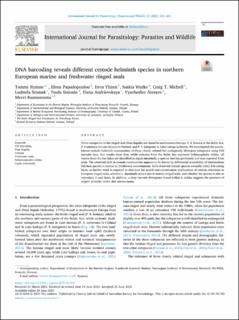| dc.contributor.author | Nyman, Tommi | |
| dc.contributor.author | Papadopoulou, Elena | |
| dc.contributor.author | Ylinen, Eeva | |
| dc.contributor.author | Wutke, Saskia | |
| dc.contributor.author | Michell, Craig T. | |
| dc.contributor.author | Sromek, Ludmila | |
| dc.contributor.author | Sinisalo, Tuula | |
| dc.contributor.author | Andrievskaya, Elena | |
| dc.contributor.author | Alexeev, Vyacheslav | |
| dc.contributor.author | Kunnasranta, Mervi | |
| dc.date.accessioned | 2022-02-21T10:17:46Z | |
| dc.date.available | 2022-02-21T10:17:46Z | |
| dc.date.created | 2021-11-23T14:26:57Z | |
| dc.date.issued | 2021-07-01 | |
| dc.identifier.citation | International Journal for Parasitology: Parasites and Wildlife. 2021, 15 255-261. | en_US |
| dc.identifier.issn | 2213-2244 | |
| dc.identifier.uri | https://hdl.handle.net/11250/2980436 | |
| dc.description.abstract | Three subspecies of the ringed seal (Pusa hispida) are found in northeastern Europe: P. h. botnica in the Baltic Sea, P. h saimensis in Lake Saimaa in Finland, and P. h. ladogensis in Lake Ladoga in Russia. We investigated the poorly-known cestode helminth communities of these closely related but ecologically divergent subspecies using COI barcode data. Our results show that, while cestodes from the Baltic Sea represent Schistocephalus solidus, all worms from the two lakes are identified as Ligula intestinalis, a species that has previously not been reported from seals. The observed shift in cestode communities appears to be driven by differential availability of intermediate fish host species in marine vs. freshwater environments. Both observed cestode species normally infect fish-eating birds, so further work is required to elucidate the health and conservation implications of cestode infections in European ringed seals, whether L. intestinalis occurs also in marine ringed seals, and whether the species is able to reproduce in seal hosts. In addition, a deep barcode divergence found within S. solidus suggests the presence of cryptic diversity under this species name. | en_US |
| dc.language.iso | eng | en_US |
| dc.publisher | Elsevier Ltd. | en_US |
| dc.rights | Attribution-NonCommercial-NoDerivatives 4.0 Internasjonal | * |
| dc.rights.uri | http://creativecommons.org/licenses/by-nc-nd/4.0/deed.no | * |
| dc.title | DNA barcoding reveals different cestode helminth species in northern European marine and freshwater ringed seals | en_US |
| dc.type | Peer reviewed | en_US |
| dc.type | Journal article | en_US |
| dc.description.version | publishedVersion | en_US |
| dc.rights.holder | © 2021 The Authors. | en_US |
| dc.source.pagenumber | 255-261 | en_US |
| dc.source.volume | 15 | en_US |
| dc.source.journal | International Journal for Parasitology: Parasites and Wildlife | en_US |
| dc.identifier.doi | 10.1016/j.ijppaw.2021.06.004 | |
| dc.identifier.cristin | 1957877 | |
| dc.relation.project | Artsdatabanken: 27-19 | en_US |
| cristin.ispublished | true | |
| cristin.fulltext | original | |
| cristin.qualitycode | 1 | |

